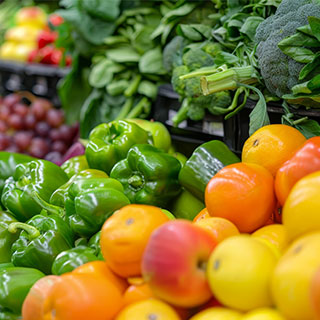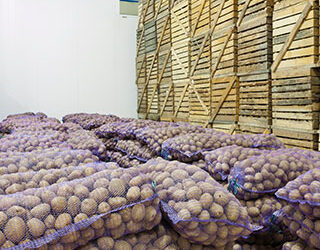Addressing Food Loss and Waste: Key to Safeguarding India’s Food Security

Food security is a growing concern as the global population continues to rise. Ensuring that everyone has access to sufficient, safe, and nutritious food is critical, especially in developing countries like India. Yet, while efforts to improve food production and distribution have increased, food loss and waste (FLW) undermine these efforts, making the goal of food security harder to achieve.
Food Loss and Waste: A Barrier to Food Security in India
Food loss and waste are significant barriers to achieving food security and meeting global sustainability goals. Food loss refers to edible food that is lost during production, post-harvest, storage, transport, and processing stages, while food waste occurs after food reaches retail stores and consumers. Both are addressed under Sustainable Development Goal (SDG) 12.3, which aims to halve global food waste and reduce food loss across production and supply chains by 2030.
 Figure 1: Food loss and waste occur across the supply chain1
Figure 1: Food loss and waste occur across the supply chain1
Globally, about 14% of food produced is lost between harvest and retail, while another 17% is wasted by consumers and retailers2. Additionally, the carbon footprint of food loss and waste is estimated at 3.3 gigatonnes of CO2 equivalent globally3, contributing to environmental degradation. In India, post-harvest losses in the horticulture sector alone are valued at INR,555.8 billion annually4, while household food waste amounts to an average of 50 kg per capita per year, resulting in approximately 68.7 million tonnes of wasted food annually5.
Minimising Food Loss and Waste Across the Supply Chain
Food waste is more commonly recognised, but food loss – happening before food even reaches retail – is far less understood. To ensure food security, it’s crucial to address both. This means not only reducing waste at the consumer level but also improving storage, handling, and transportation across the supply chain to prevent loss during production and distribution. Addressing both will reduce inefficiencies, increase food availability, and support environmental sustainability.
Addressing food loss and waste requires targeted interventions at both the policy and consumer levels. At the consumer level, simple actions like meal planning, avoiding over-purchasing, and composting can dramatically reduce food waste. At the infrastructural and policy level, developing integrated cold storage solutions with pre-cooling, sorting, and grading, DRE-based micro cold rooms facilities at the farm level; multi-product and multi-temperature cold storage; controlled atmosphere (CA) storage; packing facilities; individual quick freezing (IQF) and blast freezing in distribution hubs; and reefer vans and mobile cooling units for distributing perishable produce can significantly reduce spoilage.
Cold-Chain Infrastructure: Progress, Challenges, and Solutions
Food loss, which occurs before food reaches consumers, is a critical issue, particularly in India, where inadequate infrastructure and inefficient cold chains contribute to high levels of spoilage. Despite being the second-largest producer of horticultural products globally, India faces substantial post-harvest losses due to poor storage and distribution networks.
The Government of India has introduced several regulations to address food loss and waste, such as the Cold Storage Act of 1976, which includes guidelines for licensing and reasonable storage charges, indirectly supporting FLW reduction. Additionally, the AMPC Act regulates the marketing and sale of stored produce, while BIS certification helps ensure that standards are met for the proper preservation of food products. Together, these regulations aim to minimise food loss by safeguarding the quality and saleability of produce along the supply chain.
India has also made efforts to promote food recovery. The Food Safety and Standards Authority of India (FSSAI) introduced 2019 regulations encouraging businesses to recover surplus food and facilitate legitimate food donations, directly targeting FLW reduction. Moreover, national-level surveys conducted by NITI Aayog have emphasised the importance of waste segregation and home composting, which could prevent up to 15 billion tonnes of food from being wasted in landfills. Despite these initiatives, reporting on SDG 12.3 remains insufficient, as noted by NITI Aayog in 2019, highlighting the need for stronger accountability measures to track and reduce FLW.
The development of cold chain infrastructure is one of the most effective solutions for addressing food loss, with the Government of India offering grants and subsidies through various missions, schemes, and committees under multiple ministries. These efforts aim to promote commercial financing for the cold chain sector. However, challenges remain regarding the efficiency, utilisation, and energy consumption of cold chain infrastructure. While progress has been made, cold chains are still not optimally serving to preserve the quality and quantity of produce, pointing to the need for further innovation and investment.
Therefore it’s critical to strengthen institutions and policies that not only standardise loss estimation but also incentivise behavioural changes across the food value chain. Further research is crucial to understand the factors contributing to food loss and waste, and how these factors impact various stages of the food supply chain. Technological advancements also play a key role in reducing FLW, and organisations like AEEE, which promote sustainable practices, provide valuable insights into how energy efficiency and improved infrastructure can help mitigate food loss and waste.
The Road Ahead: Building a Sustainable Future by Reducing FLW
Reducing food loss and waste is essential not only for achieving food security but also for protecting the environment and meeting global sustainability goals. Collaboration across government, industry, and consumers is essential. On this International Day of Awareness of Food Loss and Waste, we are reminded of the urgent need to take action. By building efficient cold chain systems, promoting mindful consumer habits, and implementing robust policies, India can reduce food loss and waste, creating a more sustainable food system. Reducing both food loss and waste is critical for securing food for the future and achieving the targets set under SDG 12.3.
[1] Food loss and waste in India: the knows and unknowns, WRI, 2021. Retrieved from: https://wri-india.org/sites/default/files/Food%20Losss%20and%20Waste_August%202021.pdf
[2] The state of Food and Agriculture, FAO, 2019. Retrieved from: https://openknowledge.fao.org/server/api/core/bitstreams/11f9288f-dc78-4171-8d02-92235b8d7dc7/content
[3] Food wastage footprint, impact on natural resources, FAO, 2013. Retrieved from: https://www.fao.org/4/i3347e/i3347e.pdf
[4] Reducing post-harvest losses in Indian agriculture- A Case Study of Selected Crops, ADMI, 2024. Retrieved from: https://icrier.org/pdf/Policy_Brief_20.pdf
[5] Food waste index report, UNEP, 2021. Retrieved from: https://www.unep.org/resources/report/unep-food-waste-index-report-2021
This blog is written by Akansha Ujala Dean




